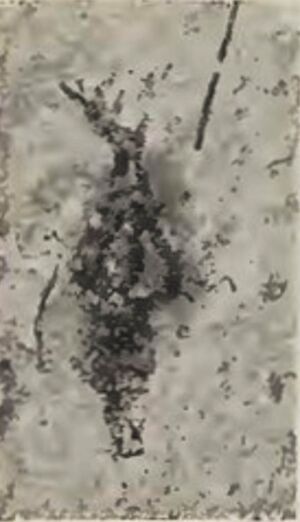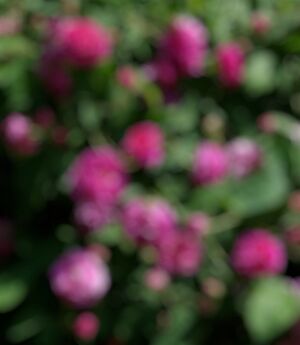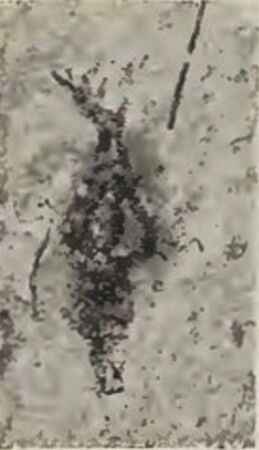Rosa ruskineana Cockerell
Fossile-Rose, 1908 - beschrieben vom Paläobotaniker/ described by the palaeobotanist/ décrit par le paléobotaniste Theodore Dru Alison Cockerell, USA
Eltern/ parentage/ parents: Botanische Rose/ Wild Rose/ Rosier botanique
Vermutliche Synonyme/ Presumed synonyms/ synonymes présumés: Rosa hilliae Lesq., Rosa dubia C.O.Weber
Die Synonyme wurden beschrieben von den Botanikern/ The synonyms were described by the botanists/ Les synonymes ont été décrits par les botanistes Daniel Isaac Axelrod, USA, Shigeru Miki, Japan, Hermann Engelhardt, Deutschland, Charles Arthur Hollick, USA, Ralph Works Chaney, USA, Frank Hall Knowlton, USA, Gábor (Gabriel) Andreánszky, Ungarn, Oswald von Heer, Schweiz, Theodore Dru Alison Cockerell, USA, Hsen Hsu Hu, China, Toshimasa Tanai, Japan, Wladyslaw Szafer, Polen
Allgemeines • Preface • Remarques
Dies ist wohl die einzige Ur-Rose, von der eine fossile Knospe gefunden wurde. Gewidmet hat Theodore Dru Alison Cockerell seinen Fund John Ruskin (* 8.02.1819, † 20.01.1900)[1]. Er war ein englischer Schriftsteller, Philosoph, Kunstkritiker und Universalgelehrter des viktorianischen Zeitalters. Er schrieb über so unterschiedliche Themen wie Geologie, Architektur, Mythen, Ornithologie, Literatur, Bildung, Botanik und politische Ökonomie.
Das Bild lässt es erahnen, aber die Beschreibung macht es deutlich: Dies ist die älteste Moosrose und ihr aller Vorfahre! Der Fund stammt aus dem Oligozän[2], ist also 33,9 - 23,03 Mio. Jahre alt.
This is probably the only original rose of which a fossil bud has been found. Theodore Dru Alison Cockerell dedicated his find to John Ruskin (* 8 February 1819, † 20 January 1900)[1]. He was an English writer, philosopher, art critic and polymath of the Victorian era. He wrote on subjects as diverse as geology, architecture, myths, ornithology, literature, education, botany and political economy.
The picture gives a foreboding hint, but the description makes it clear: this is the oldest Moss rose and its ancestor! The find dates from the Oligocene[2], i.e. 33.9 - 23.03 million years old.
Il s'agit probablement de la seule rose primitive dont un bourgeon fossile a été trouvé. Theodore Dru Alison Cockerell a dédié sa découverte à John Ruskin (* 8.02.1819, † 20.01.1900)[1]. Il était un écrivain, philosophe, critique d'art et érudit universel anglais de l'époque victorienne. Il a écrit sur des sujets aussi divers que la géologie, l'architecture, les mythes, l'ornithologie, la littérature, l'éducation, la botanique et l'économie politique.
L'image le laisse deviner, mais la description le montre clairement : il s'agit de la plus ancienne rose de mousse et de son ancêtre à tous ! La découverte date de l'Oligocène[2], c'est-à-dire de 33,9 à 23,03 millions d'années.
Originale Beschreibung • Original description • Description originale
Übersetzung der Beschreibung von T. D. A. Cockerell in "Descriptions of Tertiary plants, 1908":
Repräsentiert durch eine Knospe von etwa 16 mm Länge und 6 mm Durchmesser. Hypanthium subglobös, zweifellos eine praktisch kugelförmige Frucht erzeugend, mit winzigen Stacheln bedeckt; Kelchblätter mit sehr großen und dickstieligen Drüsen oder Drüsenhaaren auf der basalen Hälfte, diese sehr viel größer als die Stacheln des Hypanthiums; apikaler Teil der Kelchblätter lang, mit drei oder vier großen Lappen auf jeder Seite.
Florissant, Station 13 B (W. P. Cockerell, 1908). Durch den Charakter des Hypanthiums ist sie offensichtlich mit Rosa cherokeensis Donn. verwandt, aber die Kelchblätter sind stark gelappt. Eine solche Rose würde dreiblättrige Blätter haben, und diese müssten denen von R. hilliae Lesq. zumindest weitgehend ähneln. Da es jedoch unmöglich ist, die Knospe eindeutig mit den Blättern von R. hilliae in Verbindung zu bringen (wir haben letztere nicht gefunden), gebe ich der ersteren einen eigenen Namen und widme sie John Ruskin, dessen Kopie von Lindleys "Rosarium. Monographia", mit vielen Randbemerkungen, in meiner Bibliothek steht.
Original description by T. D. A. Cockerell in "Descriptions of Tertiary plants, 1908":
Represented by a bud about 16mm long, and six in diameter. Hypanthium subglobose, no doubt producing a practically spherical fruit, covered with minute spines; sepals with very large and thick-stalked glands or gland hairs on the basal half, these very much larger than the spines of the hypanthium; apical portion of sepals long, with three or four large lobes on each side.
Florissant, Station 13 B (W. P. Cockerell, 1908). By the character of the hypanthium this is evidently related to Rosa cherokeensis Donn., but the sepals are strongly lobed. Such a rose would have trifoliate leaves, and these should resemble those of R. hilliae Lesq., at least to a considerable degree. As, however, it is impossible definitely to connect the bud with the leaves of R. hilliae (we have not found the latter), I give the former a distinctive name; dedicating it to John Ruskin, whose copy of Lindley’s "Rosarium. Monographia," with many marginal notes, is in my library.
Trduction du description de T. D. A. Cockerell dans "Descriptions of Tertiary plants, 1908" :
Représenté par un bourgeon d'environ 16 mm de long et 6 mm de diamètre. Hypanthium subglobuleux, produisant sans doute un fruit pratiquement sphérique, recouvert de minuscules aiguillons ; sépales avec de très grandes glandes ou poils glanduleux à tige épaisse sur la moitié basale, ceux-ci beaucoup plus grands que les aiguillons de l'hypanthium ; partie apicale des sépales longue, avec trois ou quatre grands lobes de chaque côté.
Florissant, station 13 B (W. P. Cockerell, 1908). Par le caractère de l'hypanthium, elle est manifestement apparentée à Rosa cherokeensis Donn., mais les sépales sont fortement lobés. Un tel rosier aurait des feuilles à trois folioles, et celles-ci devraient ressembler, au moins en grande partie, à celles de R. hilliae Lesq. Mais comme il est impossible d'établir un lien clair entre le bourgeon et les feuilles de R. hilliae (nous n'avons pas trouvé ces dernières), je donne au premier son propre nom et je le dédie à John Ruskin, dont la copie du "Rosarium. Monographia", avec de nombreuses annotations marginales, se trouve dans ma bibliothèque.
Fundort • Find location • Lieu de découverte
Diese Rosenknospe wurde in den Florissant Fossil Beds[3] in Teller County, Colorado, USA gefunden.
This rose bud was found in the Florissant Fossil Beds[3] in Teller County, Colorado, USA.
Ce bouton du rosier a été trouvé dans les Florissant Fossil Beds[3] dans le comté de Teller, Colorado, États-Unis.
- Rosa ruskiniana
Zum Vergrößern anklicken • click to enlarge • cliquez pour agrandir
↑ Nach oben • Top • Vers le haut ↑
Einzelnachweis • Footnotes • Notes
Weblinks • External links • Liens externes
Literatur • Literature • Littérature
- Theodore D. A. Cockerell, Descriptions of Tertiary plants, 1908 Seite 540, 541


